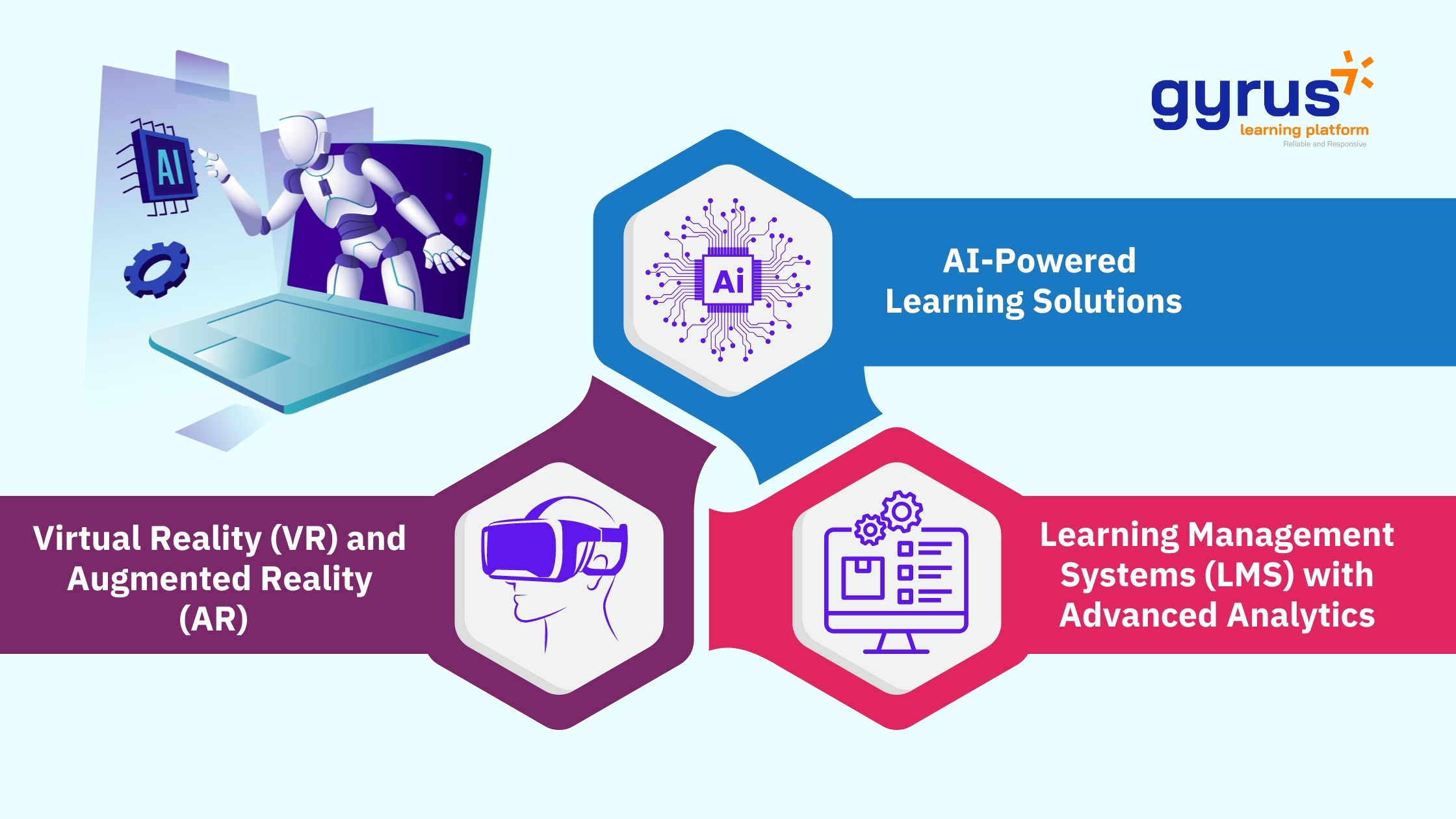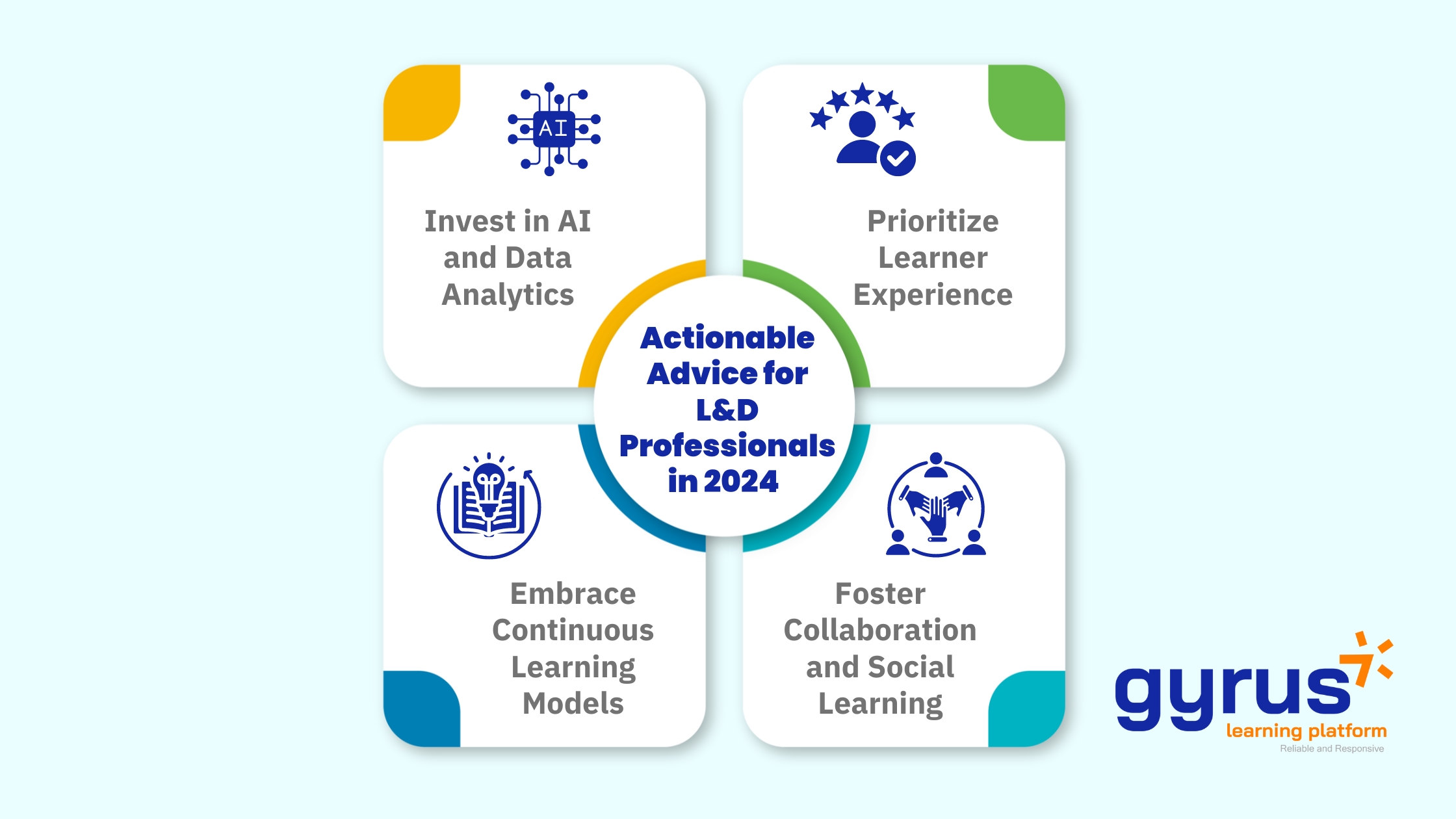In 2024, learning and development trends stand at a critical intersection of rapid technological advancement and evolving workforce demands. Organizations are increasingly recognizing that continuous learning is essential for staying competitive.
Industry analysts like Josh Bersin, John Leh, and Craig Weiss have closely observed these shifts, offering insights into how L&D is evolving. This article explores the top learning and development trends reshaping L&D in 2024 and their impact on businesses worldwide.
Top 3 Emerging Technologies in Learning and Development Trends
1. AI-Powered Learning Solutions
Integrating AI into personalized learning experiences is becoming more prevalent, allowing for individually tailored learning and development. AI can assess a learner’s performance and deliver content based on their learning style, looking at factors such as strengths, weaknesses, engagement, and more. For example, AI might suggest extra practice for skills that learners struggle with, while fast-tracking high performers with advanced material.
Expert L&D analyst Josh Bersin discusses how AI is transforming corporate learning by automating administrative tasks and creating personalized learning paths. Instead of generic, role-based learning paths, AI customizes paths based on each learning, optimizing learner experience.
Additionally, AI can automate traditionally time-consuming tasks including administrative and routine functions. This allows organizations to put their time and efforts towards higher-value activities.
AI-powered tools such as adaptive learning systems, chatbots, and automated content recommendations are transforming corporate learning. Adaptive learning ensures that learners receive the right content at the right time, chatbots provide instant, 24/7 support, and AI-driven recommendations guide learners toward relevant materials based on their needs.
2. Virtual Reality (VR) and Augmented Reality (AR)
Virtual Reality (VR) and Augmented Reality (AR) are becoming increasingly common in fields such as manufacturing, healthcare, and defense. Craig Weiss, CEO of The Craig Weiss Group, highlights that through these technologies, immersive learning experiences are made possible for essential fields to learn critical skills in a risk-free environment, drastically improving safety and confidence during training. VR and AR enhance training by allowing workers to perfect procedures while avoiding real-world hazards.
Additionally, AR and VR provide real-time learner feedback, accelerating skill development for complex tasks such as operating machinery or performing medical procedures.
3. Learning Management Systems (LMS) with Advanced Analytics
Today’s Learning Management Systems (LMS) are evolving with robust analytics that track learner engagement, outcomes, and more. With real-time data insights, organizations can now tailor learning programs to meet specific business goals, improve completion rates, and identify gaps in skills.
John Leh, Founder and CEO of Talented Learning states that LMSs are rapidly evolving and real-time analytics are becoming more and more important. LMSs have traditionally focused on learners and the process of learning in general, but in recent years, specialists have emerged with many LMS companies focusing on clearly defined audiences such as a particular niche or sector.
Additionally, he stated that cloud-based learning systems are becoming more comprehensive, with many features including authoring, performance management, social, mobile, analytics, etc. all being able to be put into one system.
Also, LMS vendors are providing out-of-the-box integrations, allowing organizations to easily integrate countless applications and tools with their LMS. Examples of integration categories include HRIS, CRM, Analytics, eCommerce, and more.
Best 3 Evolving Training Methodologies
1. Personalized Learning and Microlearning
In today’s fast-paced environment, there is a shift towards learner-centric, flexible training approaches for employees. There is an increasing focus on bite-sized content tailored to specific learner needs. Josh Bersin defines micro-learning as “things we can quickly read, view, or consume and they only take 10 minutes or less. These may be a video, a blog, or a set of instructional questions that help us think differently than we did before.”
The ways employees work have rapidly changed, with distractions, messages, and emails being factors that constantly change employee focus. According to Josh Bersin, employees take less than 25 minutes a week to put tasks and distractions aside and learn new skills and information.
Shifting the focus to individualized learning through bite-sized microlearning content is becoming more prominent to increase learner engagement and knowledge retention. A hybrid of personalized and bite-sized content aligns with the fast-paced, ever-evolving needs of today’s workforce.
2. Upskilling and Reskilling for Workforce Development
With technology advancing rapidly, organizations must prioritize upskilling and reskilling to keep pace with new technologies and changing job roles. Craig Weiss emphasizes that skill mapping is essential in identifying the skills employees need for both current and future roles. By delivering targeted learning programs based on these mapped skills, companies can better prepare their workforce for the demands of the digital age.
Investing in upskilling and reskilling programs not only closes skill gaps but also boosts employee retention, engagement, and performance.
3. Soft Skills and Leadership Development
Traditionally, organizations only put emphasis on having hard skills to get hired or remain employed in a job role. With traditional job roles forced to shift into dynamic positions and new technologies emerging, developing soft skills such as adaptability, communication, and critical thinking alongside technical skills has become essential.
Strong leaders are critical to building resilient organizations that can respond to internal pressures and market demands. By investing in leadership and soft skills development, companies can ensure that their teams are not only technically proficient but also equipped to thrive in today’s fast-evolving workplace.
Best 4 Actionable Advice for L&D Professionals in 2024
1. Invest in AI and Data Analytics
AI and analytics can create more effective learning paths, automate administrative tasks, and provide data-driven insights to measure the ROI of L&D programs.
2. Prioritize Learner Experience
Creating an engaging, positive learning experience will drive better performance outcomes, with a greater focus on retention and engagement.
3. Embrace Continuous Learning Models
Promote continuous learning with microlearning, reskilling initiatives, and on-demand learning solutions to ensure employees stay up-to-date in a rapidly changing world.
4. Foster Collaboration and Social Learning
Encourage peer learning and engagement through social collaboration tools to build community and culture.
As we move through 2024, the rapid evolution of Learning and Development trends continues to reshape how organizations equip their workforce for the future. The trends outlined—AI integration, immersive technologies like VR and AR, advanced analytics, and personalized learning—are not merely fads but signals of a transformative shift in how we approach corporate training. These developments will serve as the foundation for what’s to come in the next few years. Click here to learn why social learning is important.
Looking Ahead to 2025 and 2026, We Expect Several Key Trends to Emerge and Deepen
1. Hyper-Personalized Learning at Scale
While personalized learning is gaining momentum today, the coming years will see organizations leveraging AI to create even more granular, individualized learning paths. These paths will be based not just on learner performance but on behavioral data, work habits, and real-time feedback. AI will predict learning needs before they even arise, ensuring employees remain one step ahead.
2. The Rise of Predictive Analytics
Advanced analytics will move from tracking past learner behaviors to predicting future skills needs. By 2026, predictive models will allow organizations to anticipate skill gaps before they become critical, helping businesses build proactive development strategies that align with future goals and market changes.
3. Seamless Integration of Learning with Workflows
Learning will become more integrated into the flow of work. By 2025, learning and performance support tools will be embedded into everyday systems employees use, like CRM platforms or communication tools, providing instant learning resources exactly when and where they’re needed.
4. Even Greater Focus on Emotional Intelligence and Well-being
The importance of soft skills will expand beyond communication and leadership, with a new focus on emotional intelligence, empathy, and well-being. As workplace dynamics change—driven by hybrid models, global collaboration, and AI—the ability to manage emotions and foster positive relationships will be crucial for team success.
The learning and development trends landscape is evolving quickly, and forward-thinking organizations that embrace these trends will be better positioned to attract talent, retain employees, and remain competitive in the marketplace. The next few years will bring unprecedented opportunities for innovation in learning, as technological advancements and human-centered development converge to redefine what it means to grow and learn in the modern workplace.

